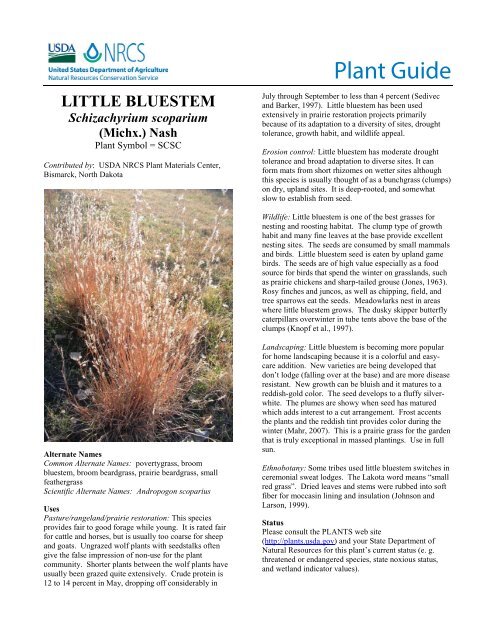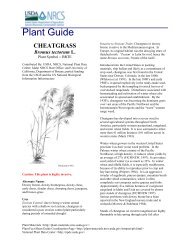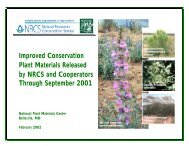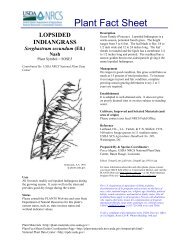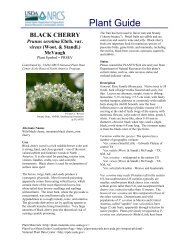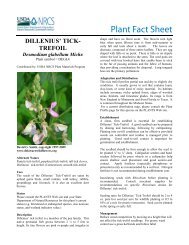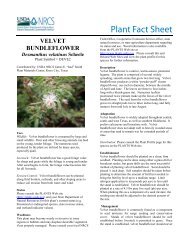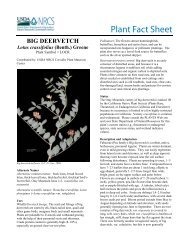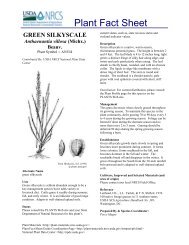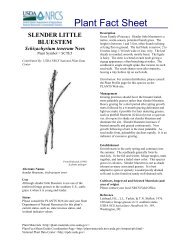Little Bluestem Schizachyrium scoparium Plant Guide - USDA Plants ...
Little Bluestem Schizachyrium scoparium Plant Guide - USDA Plants ...
Little Bluestem Schizachyrium scoparium Plant Guide - USDA Plants ...
Create successful ePaper yourself
Turn your PDF publications into a flip-book with our unique Google optimized e-Paper software.
LITTLE BLUESTEM<br />
<strong>Schizachyrium</strong> <strong>scoparium</strong><br />
(Michx.) Nash<br />
<strong>Plant</strong> Symbol = SCSC<br />
Contributed by: <strong>USDA</strong> NRCS <strong>Plant</strong> Materials Center,<br />
Bismarck, North Dakota<br />
Alternate Names<br />
Common Alternate Names: povertygrass, broom<br />
bluestem, broom beardgrass, prairie beardgrass, small<br />
feathergrass<br />
Scientific Alternate Names: Andropogon scoparius<br />
Uses<br />
Pasture/rangeland/prairie restoration: This species<br />
provides fair to good forage while young. It is rated fair<br />
for cattle and horses, but is usually too coarse for sheep<br />
and goats. Ungrazed wolf plants with seedstalks often<br />
give the false impression of non-use for the plant<br />
community. Shorter plants between the wolf plants have<br />
usually been grazed quite extensively. Crude protein is<br />
12 to 14 percent in May, dropping off considerably in<br />
<strong>Plant</strong> <strong>Guide</strong><br />
July through September to less than 4 percent (Sedivec<br />
and Barker, 1997). <strong>Little</strong> bluestem has been used<br />
extensively in prairie restoration projects primarily<br />
because of its adaptation to a diversity of sites, drought<br />
tolerance, growth habit, and wildlife appeal.<br />
Erosion control: <strong>Little</strong> bluestem has moderate drought<br />
tolerance and broad adaptation to diverse sites. It can<br />
form mats from short rhizomes on wetter sites although<br />
this species is usually thought of as a bunchgrass (clumps)<br />
on dry, upland sites. It is deep-rooted, and somewhat<br />
slow to establish from seed.<br />
Wildlife: <strong>Little</strong> bluestem is one of the best grasses for<br />
nesting and roosting habitat. The clump type of growth<br />
habit and many fine leaves at the base provide excellent<br />
nesting sites. The seeds are consumed by small mammals<br />
and birds. <strong>Little</strong> bluestem seed is eaten by upland game<br />
birds. The seeds are of high value especially as a food<br />
source for birds that spend the winter on grasslands, such<br />
as prairie chickens and sharp-tailed grouse (Jones, 1963).<br />
Rosy finches and juncos, as well as chipping, field, and<br />
tree sparrows eat the seeds. Meadowlarks nest in areas<br />
where little bluestem grows. The dusky skipper butterfly<br />
caterpillars overwinter in tube tents above the base of the<br />
clumps (Knopf et al., 1997).<br />
Landscaping: <strong>Little</strong> bluestem is becoming more popular<br />
for home landscaping because it is a colorful and easycare<br />
addition. New varieties are being developed that<br />
don’t lodge (falling over at the base) and are more disease<br />
resistant. New growth can be bluish and it matures to a<br />
reddish-gold color. The seed develops to a fluffy silverwhite.<br />
The plumes are showy when seed has matured<br />
which adds interest to a cut arrangement. Frost accents<br />
the plants and the reddish tint provides color during the<br />
winter (Mahr, 2007). This is a prairie grass for the garden<br />
that is truly exceptional in massed plantings. Use in full<br />
sun.<br />
Ethnobotany: Some tribes used little bluestem switches in<br />
ceremonial sweat lodges. The Lakota word means “small<br />
red grass”. Dried leaves and stems were rubbed into soft<br />
fiber for moccasin lining and insulation (Johnson and<br />
Larson, 1999).<br />
Status<br />
Please consult the PLANTS web site<br />
(http://plants.usda.gov) and your State Department of<br />
Natural Resources for this plant’s current status (e. g.<br />
threatened or endangered species, state noxious status,<br />
and wetland indicator values).
Weediness<br />
This plant may become weedy or invasive in some<br />
regions or habitats and may displace more desirable<br />
vegetation if not properly managed. The seed is light and<br />
fluffy, and may spread to the surrounding areas,<br />
especially in a garden or landscape setting. Seed is<br />
generally dispersed a short distance from the parent<br />
plants. The maximum dispersal is only 5 to 6 feet and<br />
seedling vigor is weak (Uchytil, 1989). Consult with your<br />
local NRCS Field Office, Cooperative Extension Service<br />
office, state natural resource, or state agriculture<br />
department regarding its status and use. Weed<br />
information is also available from the PLANTS Web site<br />
at http://plants.usda.gov/. Consult the Related Web Sites<br />
on the <strong>Plant</strong> Profile for this species for further<br />
information.<br />
Description<br />
<strong>Little</strong> bluestem is a tufted (sometimes with short<br />
rhizomes), warm-season (C4), perennial grass broadly<br />
distributed and native to the U.S. and Canada. Because of<br />
this broad distribution, little bluestem exhibits significant<br />
ecotypic variation. <strong>Plant</strong>s vary in height, color, length of<br />
leaves, flowering, and clump diameter (<strong>USDA</strong>, 1983;<br />
Uchytil, 1989). It grows from 1 to 3 feet tall with culms<br />
slightly flattened. The blades are folded, sometimes<br />
rolled inward, and smooth to hairy. They are 2 to 12<br />
inches long, 1.5-6 mm wide, pointed with sheaths keeled<br />
and usually smooth. The ligule is a fringed membrane<br />
0.5-2.5 mm long. The culms terminate in a single raceme<br />
1-3 inches long. The pediceled spikelets are 3-6 mm long<br />
with pedicels flattened. The awns of the fertile lemmas<br />
are 9-16 mm long, bent and twisted. The anthers are 2-4<br />
mm long (Sedivec and Barker, 1997). Seed averages<br />
225,000 to 250,000 bearded seeds per pound (Uchytil,<br />
1989).<br />
Distribution: <strong>Little</strong> bluestem is found throughout the<br />
lower provinces of Canada and all states of the U.S.,<br />
except Nevada and Washington. For current distribution,<br />
please consult the <strong>Plant</strong> Profile page for this species on<br />
the PLANTS Web site.<br />
Habitat: This midgrass is a tallgrass prairie increaser and<br />
mixed prairie decreaser. <strong>Little</strong> bluestem typically occurs<br />
on dry upland sites, especially on ridges, hilltops, and<br />
steep slopes. It also occurs on limey subirrigated sites<br />
and in prairie fens. It is found in areas receiving 10 to 40<br />
inches of mean annual precipitation and plant hardiness<br />
zones 3 to 9.<br />
Adaptation<br />
<strong>Little</strong> bluestem is adapted to soils ranging from sandy to<br />
clay-loam in texture. It begins growth in late spring after<br />
cool-season species have already developed (Uchytil,<br />
1989). It has been observed that little bluestem phenology<br />
follows a well-defined pattern. Periods of active growth<br />
as well as stage of maturity are directly related to the<br />
length of the growing season (Miller, 1967; <strong>USDA</strong>,<br />
1983).<br />
Establishment<br />
Establishment from seed is considered fair. Seedling<br />
vigor and growth is relatively poor, and few plants<br />
produce seed during the planting year. Seed this warmseason<br />
species from late spring to early summer. <strong>Little</strong><br />
bluestem will not germinate until the soil temperature<br />
reaches 50 degrees F. Seed should be planted shallow (no<br />
deeper than ½ inch) into a firm, weed-free seedbed.<br />
Germination can be expected in 2-4 weeks under ideal<br />
conditions with good moisture. The seeding rate varies<br />
from 4-12 pounds pure live seed per acre. The higher<br />
seeding rate is used where higher precipitation supports<br />
higher plant populations. Generally, little bluestem is<br />
seeded with a mixture of other species rather than alone.<br />
<strong>Little</strong> bluestem establishes quicker from vegetative<br />
material, or plugs because of strong, fibrous roots.<br />
Management<br />
<strong>Little</strong> bluestem begins growth later in the spring after the<br />
cool-season species have already developed. It tolerates<br />
glyphosate when dormant, and other herbicides as labeled<br />
for grasses. Weed control can be accomplished by<br />
mowing, especially the first year when seedling grass is<br />
short. It is minimally affected by fire if burned dormant<br />
and changes little in frequency of occurrence due to fire.<br />
<strong>Little</strong> bluestem is relatively resistant to fire under moist<br />
conditions. The growing points (apical meristem) are<br />
slightly more than an inch above the soil surface (Uchytil,<br />
1989). <strong>Little</strong> bluestem in the immature growth phase is<br />
considered a nutritional, palatable grass for all classes of<br />
livestock in June and early July in studies in North and<br />
South Dakota. Palatability is lower than many other<br />
native warm-season grasses, especially when seed stalks<br />
are present. Proper grazing management is critical to<br />
improve grazing efficiency. <strong>Little</strong> bluestem is an<br />
increaser under season long grazing systems. Higher stock<br />
densities such as rotational grazing systems will achieve<br />
greater use of more plants. Recommended stubble height<br />
of 3 to 4 inches is required to assure stand longevity.<br />
Although not usually recommended for hay production,<br />
little bluestem can make fair to good hay when part of a<br />
native hayland mixture (Sedivec et al., 2008). It is a<br />
popular species to include in prairie restoration seedings<br />
because of its wide adaptation and high wildlife value.<br />
<strong>Plant</strong>s will sometimes die from the center out in the clump<br />
if the plants become too dry. Burning at the opportune<br />
time can help to reduce the population of cool-season<br />
competing vegetation, as well as woody species.<br />
Pests and Potential Problems<br />
A leaf spot disease was found to be widespread in a little<br />
bluestem nursery established at Mandan, North Dakota,<br />
from plants collected in North Dakota, South Dakota, and<br />
Minnesota. Phyllosticta andropogonivora was<br />
consistently isolated from leaves showing leaf spot<br />
symptoms. The fungus was also isolated from native
prairie plants. The fungus was pathogenic to little<br />
bluestem, big bluestem (Andropogon gerardii), and sand<br />
bluestem (Andropogon halli) (Krupinsky and Tober,<br />
1990).<br />
Environmental Concerns<br />
This grass is primarily a bunchgrass that will spread some<br />
by seed. The seed is light and fluffy and it will move to<br />
adjacent areas. Bare soil may allow seed to germinate,<br />
but it is usually not a problem. Random plants in a<br />
natural landscape are usually not considered undesirable<br />
because it is a native species.<br />
Seeds and <strong>Plant</strong> Production<br />
Seed into a firm seedbed in early spring for best results.<br />
Seed in a solid stand (8 inches or less row spacing) at<br />
approximately 4.5 lb/acre (eastern ND rate), or 30 seeds<br />
per linear foot of row, or 2.5 lb/acre for 24-inch rows.<br />
Glyphosate may be used for weed control immediately<br />
after seeding to kill everything green and growing.<br />
Bromoxynil and imazethapyr are labeled for controlling<br />
various weed species. Always read and follow the label<br />
directions when applying herbicides. Consult with the<br />
local extension service or Land Grant University for<br />
assistance with recommendations on herbicides and<br />
application rate. Mention of a trademark or proprietary<br />
product does not constitute a guarantee or warranty of the<br />
product by the U.S. government and does not imply its<br />
approval to the exclusion of other products that may also<br />
be suitable.<br />
Seed is best harvested from the plant using a commercial<br />
stripper at 600 to 800 rpm at the hard dough or mature<br />
seed stage. This is because of the light, fluffy seed, and<br />
the uneven maturity. Straight combining is another<br />
method of harvest when most of the seed has matured.<br />
Average dockage of combined seed is 60 percent. Seed<br />
should be air dried for a couple days. Seed for the bin<br />
should be dried to 12 percent or less, and sacked seed<br />
should be 15 percent or less. Average yield is 200 to 300<br />
lb/ac irrigated and 75 to 150 lb/acre dryland. Processing<br />
the seed is fairly difficult because of the fuzziness of<br />
individual spikelets. It should be debearded first. A<br />
hammermill works well with a 3/16-inch screen at 550<br />
rpm, and then a debearder at 200 rpm for 45 to 60<br />
minutes. Scalping or final cleaning may be done using a<br />
4-screen fanning mill. Postharvest management requires<br />
that rotary mowing, rototilling, or cultivating between<br />
rows in the fall or spring; or burning on a regular basis in<br />
early spring Smith et al., 1989)<br />
<strong>Plant</strong>s may be grown in the greenhouse using standard<br />
greenhouse procedures. Deeper containers (4 inches or<br />
more) are recommended because perennial grasses<br />
develop extensive root systems. A critical factor in<br />
growing little bluestem is daylength. A study in North<br />
Dakota required 18 hours of artificial light each day for<br />
continued growth of seedling little bluestem plants<br />
(<strong>USDA</strong>, 1983) during the winter months.<br />
<strong>Little</strong> bluestem has high genetic diversity.<br />
Cultivars, Improved, and Selected Materials (and area<br />
of origin)<br />
‘The Blues’, ‘Prairie Blues’, ‘Blue Heaven’, ‘Carousel’,<br />
and several other varieties have been developed for<br />
landscaping and ornamental use. Sources for<br />
conservation planting showing the year of release, and<br />
origin include the following:<br />
Ozark Germplasm 2010 MO<br />
Suther Germplasm 2008 NC<br />
Prairie View Indiana Germplasm 2005 IN<br />
OK Select Germplasm 2003 OK<br />
Spirit Ecovar (Canada) 2003 SK,MB<br />
Southlow Michigan Germplasm 2001 MI<br />
Itasca Germplasm 2001 ND,SD,MN<br />
Taylor Ecovar (Canada) 2000 MB,SK<br />
Southern Iowa Germplasm 1999 IA<br />
Northern Iowa Germplasm 1999 IA<br />
Northern Missouri Germplasm 1999 IA<br />
Central Iowa Germplasm 1997 IA<br />
Badlands Ecotype 1996 ND,SD<br />
‘Cimmaron’ 1979 KS,OK<br />
‘Camper’ 1973 NE,KS<br />
‘Blaze’ 1967 NE,KS<br />
‘Aldous’ 1966 KS<br />
‘Pastura’ 1964 NM<br />
References<br />
Johnson, J. and G. Larson. 1999. Grassland plants of<br />
South Dakota and the Northern Great Plains. South<br />
Dakota State University, Brookings, SD.<br />
Jones, R. 1963. Identification and analysis of lesser and<br />
greater prairie chicken habitat J. Wildl. Manage.<br />
27:757-778.<br />
Knopf, J., S. Wasowski, J. Boring, G. Keator, J. Scott, E.<br />
Glasener. 1997. A guide to natural gardening. Fog<br />
City Press, San Francisco, CA.<br />
Krupinsky J. and D. Tober. 1990. Leaf spot disease of<br />
little bluestem, big bluestem, and sand bluestem<br />
caused by Phyllosticta andropogonivora. <strong>Plant</strong> Dis.<br />
74(6):442-445.<br />
Mahr S. 2007. <strong>Little</strong> bluestem. Hort. Newsletter, Univ.<br />
of Wisconsin, Madison, WI.
Miller, R. 1967. Ecotypic variation in Andropogon<br />
scoparious and Bouteloua gracilis. Fort Collins,<br />
Colorado State University, dissertation. Abstract.<br />
Sedivec, K. and W. Barker. 1997. Selected North Dakota<br />
and Minnesota range plants. EB-69, NDSU<br />
Extension Service, Fargo, ND.<br />
Sedivec, K., D. Tober, W. Duckwitz, D. Dewald, J.<br />
Printz, and D. Craig. 2008. Grasses for the northern<br />
plains: growth patterns, forage characteristics, and<br />
wildlife values, vol. II – warm-season. <strong>USDA</strong>-<br />
NRCS, Bismarck, ND and NDSU, Fargo, ND.<br />
Smith R. and S. Smith (Ed.). 1989. Native grass seed<br />
production manual. Ducks Unlimited Canada, Oak<br />
Hammock Marsh, MB, Canada<br />
Uchytil, R. 1989. Wildlife, Animals, and <strong>Plant</strong>s<br />
<strong>Schizachyrium</strong> <strong>scoparium</strong>. [Online].<br />
(http://reference.allrefer.com/wildlife-plantsanimals/plants/graminoid/schsco/all.html).<br />
<strong>USDA</strong>-SCS. 1983. Part 1, Annual Technical Report,<br />
<strong>USDA</strong>-SCS <strong>Plant</strong> Materials Center, Bismarck, ND.<br />
Prepared By:<br />
Dwight Tober (retired) and Nancy Jensen<br />
<strong>USDA</strong> NRCS <strong>Plant</strong> Materials Center<br />
Bismarck, North Dakota<br />
Species Coordinator:<br />
Nancy Jensen<br />
<strong>USDA</strong> NRCS <strong>Plant</strong> Materials Center<br />
Bismarck, North Dakota<br />
Citation<br />
Tober,. D. and N. Jensen. 2013. <strong>Plant</strong> guide for little<br />
bluestem (<strong>Schizachyrium</strong> <strong>scoparium</strong>). <strong>USDA</strong> Natural<br />
Resources Conservation Service, <strong>Plant</strong> Materials Center,<br />
Bismarck, North Dakota 58501<br />
Published May 2013<br />
For more information about this and other plants, please<br />
contact your local NRCS field office or Conservation<br />
District at http://www.nrcs.usda.gov/ and visit the<br />
PLANTS Web site at http://plants.usda.gov/ or the <strong>Plant</strong><br />
Materials Program Web site http://plantmaterials.nrcs.usda.gov.<br />
PLANTS is not responsible for the content or availability<br />
of other Web sites.<br />
<strong>USDA</strong> IS AN EQUAL OPPORTUNITY PROVIDER AND EMPLOYER


